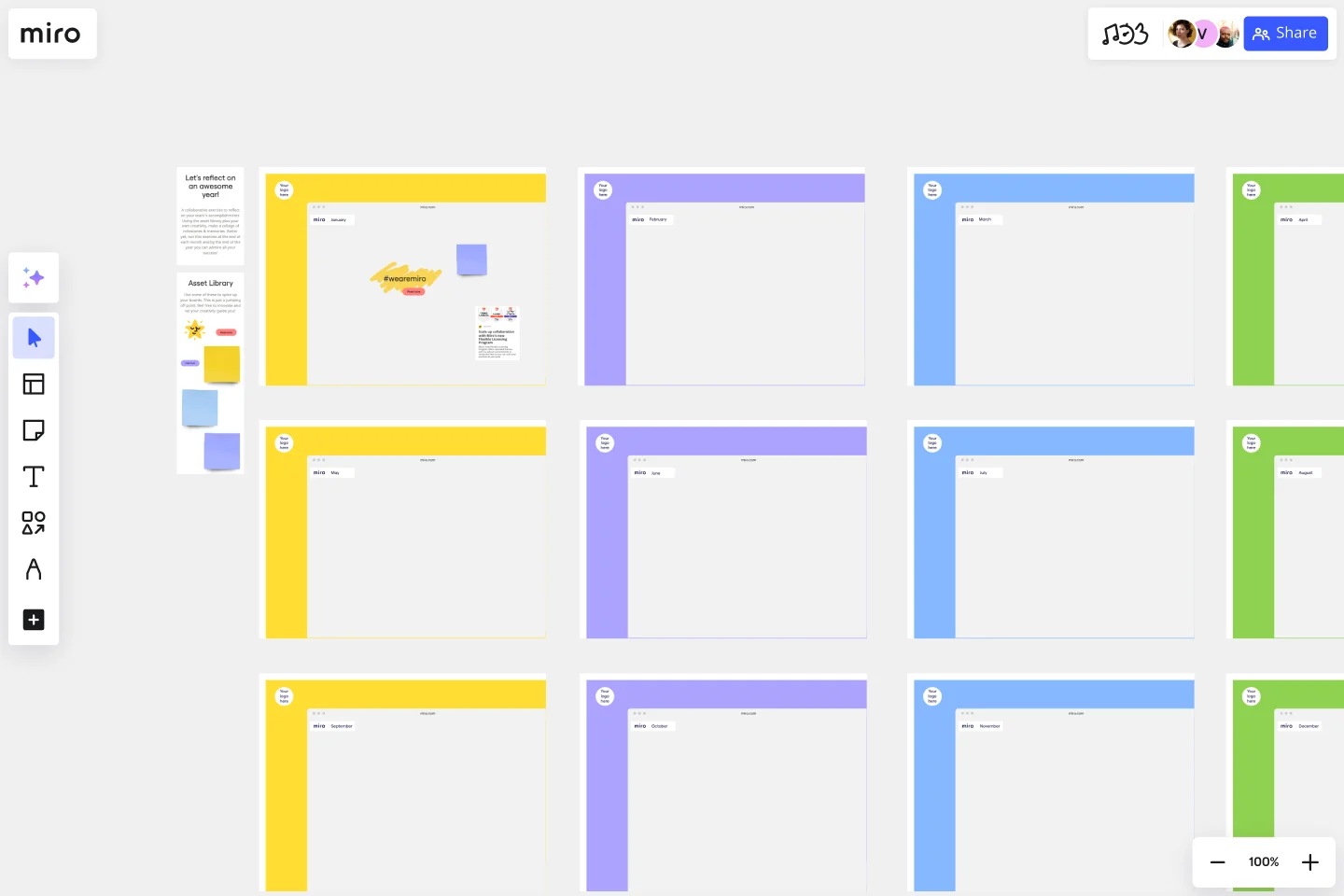Year in Review Template
Celebrate achievements and reflect on experiences and learnings with the year-in-review template.
About the Year in Review Template
As we navigate through the year, it's essential to reflect on the events, accomplishments, and experiences that have happened. The Year in Review template is a tool to capture, categorize, and communicate these moments, fostering a deeper understanding and appreciation of the year's journey.
What's a year-in-review template?
A Year in Review template is a structured visual representation that divides the year into twelve months. Each segment, corresponding to a month, provides a space for users to input highlights, notes, visuals, or any significant reminders from that time. Areas in the template can include:
Monthly frames: Clearly labeled sections for each month allow for organized input of events or experiences.
Asset library: A dedicated corner, like the one seen in the January example, provides a space for storing images, logos, or any other graphical assets that one might want to use throughout the year's review.
Colors and themes: The varying colors and designs can be tailored to represent each month's themes, moods, or significance.
How to use the year-in-review template
Editing: Easily click and edit each month's segment, adding text, images, or any other relevant content.
Expansion: Need more frames or spaces? Quickly expand the template with additional frames to accommodate more detailed reviews.
Incorporate artifacts: Any artifact or element present on the board can be effortlessly dragged and placed into the desired month.
Why should you use a year-in-review template?
Clarity and reflection: The template offers a clear snapshot of the year, enabling a concise reflection of the highs and lows.
Organized archiving: It systematically stores all memories, milestones, and significant events.
Collaborative tool: Multiple contributors can add their insights, creating a more holistic view of the year.
Versatility: It can be adapted for personal use, professional milestones, or project timelines.
Engaging presentation: Use the year recap template for presentations or discussions, providing a month-by-month walkthrough.
Discover more presentation examples in Miro to make your ideas stand out.
Is there a limit to how much I can customize the year recap template?
No. The template is fully customizable, allowing you to adjust it to suit your specific needs.
Can I share the filled-out template with others?
Of course! Sharing your review can provide valuable insights to colleagues, mentors, or any other interested parties.
Do I need any special skills to use the template?
Not at all. The template is designed to be intuitive and user-friendly, ensuring that anyone can dive in and start reflecting on their year.
Get started with this template right now.
Quick Retrospective by Online Department
Works best for:
Retrospectives, Agile Methodology
The Quick Retrospective template offers a concise and efficient framework for teams to reflect on recent iterations or projects. It provides elements for sharing successes, challenges, and action items in a streamlined format. This template enables teams to conduct retrospectives quickly and effectively, even with limited time. By promoting efficiency and focus, the Quick Retrospective empowers teams to drive meaningful improvements and maintain momentum in their work effectively.
The Hot Air Balloon Retrospective
The Hot Air Balloon is a simple activity for helping the team identify things that makes them move faster, and things that slow them down.
Retrospective in the Island of Golocans
Works best for:
Retrospectives, Meetings, Agile Methodology
The Retrospective in the Island of Golocans template offers a creative and imaginative setting for retrospectives, transporting participants to a fictional island setting. It provides elements for reflecting on past iterations, sharing insights, and brainstorming improvements. This template enables teams to step outside their usual environment and approach retrospectives with a fresh perspective. By promoting creativity and storytelling, the Retrospective in the Island of Golocans empowers teams to engage in meaningful discussions, generate new ideas, and foster a culture of innovation effectively.
The 4-Step Retrospective
Works best for:
Retrospectives, Agile Methodology, Meetings
The 4-Step Retrospective template offers a simple yet effective framework for conducting retrospectives. It provides steps for reflecting on what went well, what didn't go well, what could be improved, and action planning. This template enables teams to systematically review past iterations, identify areas for growth, and implement actionable improvements. By promoting a structured approach to reflection and improvement, the 4-Step Retrospective empowers teams to drive continuous learning and enhancement effectively.
Retrospective - Summer
Works best for:
Retrospectives, Agile Methodology, Meetings
The Retrospective - Summer template offers a seasonal and themed approach to retrospectives, perfect for capturing the spirit of summer. It provides elements for reflecting on achievements, experiences, and goals amidst the summer backdrop. This template enables teams to relax, recharge, and recalibrate their efforts for the upcoming season. By promoting reflection and rejuvenation, the Retrospective - Summer empowers teams to celebrate successes, learn from setbacks, and embark on new adventures with renewed energy and enthusiasm effectively.
Starfish Retrospective
Works best for:
Retrospectives, Agile Methodology, Meetings
The Starfish Retrospective template offers a structured approach to retrospectives using the metaphor of a starfish. It provides elements for identifying what to start, stop, continue, do more of, and do less of. This template enables teams to reflect on past iterations, identify actionable insights, and prioritize improvements. By promoting clarity and focus, the Starfish Retrospective empowers teams to drive meaningful change and continuous improvement effectively.
